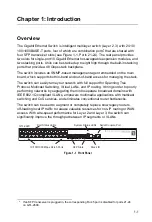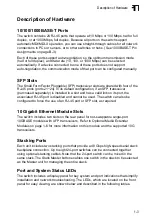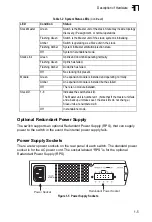
Introduction
1-2
1
Figure 1-2 Rear Panel
Switch Architecture
The Gigabit Ethernet switch employs a wire-speed, non-blocking switching fabric.
This permits simultaneous wire-speed transport of multiple packets at low latency on
all ports. The switch also features full-duplex capability on all ports, which effectively
doubles the bandwidth of each connection.
For communications between different VLANs, the switch use IP routing. For
communications within the same VLAN, they use store-and-forward switching to
ensure maximum data integrity. With store-and-forward switching, the entire packet
must be received into a buffer and checked for validity before being forwarded. This
prevents errors from being propagated throughout the network.
The switch includes built-in stacking ports that enable up to eight units to be
connected together through a 48 Gbps stack backplane. The switch stack can be
managed from a master unit using a single IP address.
The switch also includes two slots on the rear panel for slide-in single-port
10GBASE modules with XFP transceivers.
Network Management Options
The switch contains a comprehensive array of LEDs for “at-a-glance” monitoring of
network and port status. It also includes a management agent that allows you to
configure or monitor the switch using its embedded management software, or via
SNMP applications. To manage each switch, you can make a direct connection to
the console port (out-of-band), or you can manage the switch through a network
connection (in-band) using Telnet, the on-board web agent, or SNMP-based network
management software.
For a detailed description of GTL-2690’s advanced features, refer to the Gigabit
Ethernet Switch Management Guide.
Stackin
g
Ports
Po
w
er Socket
Re
d
un
d
ant Po
w
er Socket
Mo
d
u
l
e S
l
ots
Summary of Contents for GTL-2690
Page 2: ......
Page 4: ......
Page 18: ...xiv Figures ...
Page 26: ...Introduction 1 8 1 ...
Page 34: ...2 8 Network Planning 2 ...
Page 44: ...3 10 Installing the Switch 3 ...
Page 56: ...A 4 Troubleshooting A ...
Page 62: ...B 6 Cables B ...
Page 73: ...Index Index 3 V VLANs routing 2 6 tagging 2 5 W web based management 1 2 ...
Page 74: ...Index Index 4 ...
Page 75: ......






























